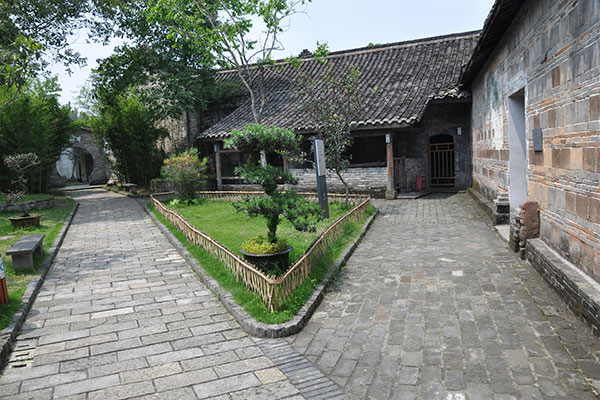
The historical town of Anren in Sichuan province boasts museums and estates of warlords, who built massive mansions in the early 20th century.[Photo/China Daily]
Anren’s architecture is built upon stories in every sense. Liu Xiangrui and Erik Nilsson tour the town.
Fan Jianchuan listens to his wife-at least when she asks him to not be made into a drum after he dies.
The founder of China’s largest private museum wants his skin fashioned into the membrane of a percussion instrument beaten to announce the museum’s opening every morning.

Boom! Boom! Boom!
Then, he’d appear as a holograph to greet visitors to his museum from beyond the grave.
This way, his story can outlive his body and transcend his mortality at his shrine to history through futuristic technology.
But his spouse isn’t having it.
Nope.
His Jianchuan Museum houses a historic and historical legacy of the world and his time in it that will inform the future of the past.
It’s today home to Hero Pig-who enjoys an idyllic existence in a “smart pen” with temperature controls and absorbent floors, when not grazing on the lawn.
The porker enjoys such environs since he became a national icon after surviving on mucky charcoal while trapped for five days in a farmhouse toppled by the 2008 Wenchuan quake that left 90,000 dead or missing. His cloned piglets-genetically modified to never grow beyond 15 kilograms-were sold for 10,000 yuan ($1,500) as pets last year.
Hero Pig, too, exists in an edifice into which his life instills historical significance. His hyper-modern abode made headlines upon completion years ago.
But there’s more to Anren than the Jianchuan Museum that makes it a place built upon historical foundations by public figures.

The town is itself a museum-a settlement where warlords and their ilk constructed massive mansions in the early 20th century.
Stories built with bricks tell the tales of those who inhabited them.
These buildings flank cobblestone streets.
The small town about 40 kilometers outside Sichuan’s provincial capital, Chengdu, hosts 27 manors from the previous century’s dawn.
These are more than mere status symbols of bygone heydays for an elite whose members were often outlaws.
They tell tales of the time when Anren captivated the national imagination in the 1920s, when it produced a casting call of often-villainous characters, who amassed immense wealth in turbulent times.
These bad-boy barons built grandiose mansions in their hometown to not only nod to where they came from but also to raise eyebrows as to how far they’d come.
They declared their supersized statuses by resplendently ornamenting enormous estates that served as offices and living spaces. These hybridized local and Western styles.
They not only included modern methods to improve lighting, ventilation and dryness but also featured such facilities as parking lots and tennis courts.
Anren’s largest estate-with 205 rooms and 27 courtyards spread over 12,000 square meters-belonged to Liu Wencai.

Construction started in the ‘20s and wrapped up in the ‘40s.
Liu made his fortune as a tax officer in a nearby region ruled by his warlord brother.
How convenient. And then how inconvenient.
Liu’s brother was defeated. Liu retreated to Anren until his death.
Liu was denounced as an evil landlord after New China’s 1949 founding.
Yet he donated sums of his largely ill-gotten gains to public projects in Anren. He built streets and a water-conservancy. The buildings of the modern middle school he constructed then still serve as a section of the town’s international school.
The elite also put up high walls for privacy.
But that didn’t stop gossip from jumping the fence.
Whispers about Liu’s wives backbiting for his favor remain among residents’ favorite gossip topics.
Liu’s mansion is now a museum. It exhibits the opulent objects collected by the town’s superrich in their golden era-that is, the era where they were loaded with gold, making them superrich.
It was a gilded age of oligarchy run amok.
Other buildings that still stand from this period include the headquarters of Liu’s gang, a teahouse and a theater.
Anren also boasts more than 20 modern museums.
Its cultural wealth has enticed investors, including Overseas Chinese Town Group, which aspires to transform it into a national demonstration base integrating “unique culture, relic protection and comfortable living spaces”.
Three designated cultural towns in Sichuan, including Anren, signed a “culture plus tourism, plus urbanization” strategic agreement during the recent Culture and New Urbanization event hosted by the State Council’s Counselors’ Office and the Chinese Culture Promotion Society.
Anren hosted the event.
The town will get 10 billion yuan ($1.54 billion) to upgrade such cultural infrastructure as museums.
These buildings will present the past in the future.
Indeed, this likely means Anren’s stories will continue to march through time, to the beat of a truly different drum-even if it’s not made of human leather.
